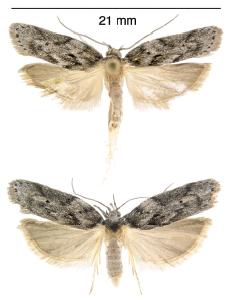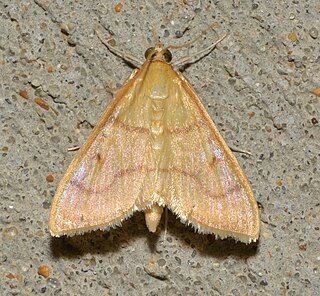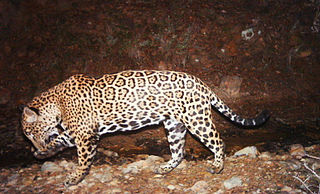
Hadrurus arizonensis, the giant desert hairy scorpion, giant hairy scorpion, or Arizona Desert hairy scorpion is the largest scorpion in North America, and one of the 8–9 species of Hadrurus in the United States, attaining a length of 14 cm (5.5 in). Its large size allows it to feed easily on other scorpions and a variety of other prey, including lizards and snakes. They have also been known to take down or fight with the Giant Desert Centipedes of Arizona. This species is usually yellow with a dark top and has crab-like pincers. It gets its common names from the brown hairs that cover its body. These hairs help it to detect vibration in the soil. A similar species is the Hadrurus spadix.
Neohelvibotys is a genus of moths of the family Crambidae.

Antaeotricha arizonensis is a moth of the family Depressariidae. It is found in the United States in the mountain ranges in south-eastern Arizona and south-western New Mexico. Although Antaeotricha arizonensis are easily differentiated within their genus through the dark spots on their forewings, the distinction between sexes of A. arizonensis can be complicated. The sexes of A. arizonensis (male&female) differentiate between themselves by distinct characteristics on their antennas and anatomy of their genitalia(Ferris, 59)
Haimbachia arizonensis is a moth in the family Crambidae. It was described by Hahn William Capps in 1965. It is found in North America, where it has been recorded from Arizona.
Daulia arizonensis is a moth in the family Crambidae. It was described by Eugene G. Munroe in 1957. It is found in North America, where it has been recorded from Arizona and Texas. In the south, the range extends from Mexico to Argentina.
Hahncappsia cayugalis is a moth in the family Crambidae described by Hahn William Capps in 1967. It is found in Guatemala, Costa Rica and Mexico.
Hahncappsia neotropicalis is a moth in the family Crambidae described by Hahn William Capps in 1967. It is found in Mexico (Xalapa), Guatemala, Costa Rica and Venezuela.
Hahncappsia potosiensis is a moth in the family Crambidae. It was described by Hahn William Capps in 1967 and it is found in the Mexican state of San Luis Potosí.
Hahncappsia alpinensis is a moth in the family Crambidae. It was described by Hahn William Capps in 1967. It is found in North America, where it has been recorded from Arizona, New Mexico and Texas.

Hahncappsia fordi is a moth in the family Crambidae. It was described by Hahn William Capps in 1967. It is found in the south-western United States, where it has been recorded from California and Arizona, as well as Sonora, Mexico.
Hahncappsia huachucalis is a moth in the family Crambidae. It was described by Hahn William Capps in 1967. It is found in North America, where it has been recorded from Arizona and Texas.
Hahncappsia pseudobliteralis is a moth in the family Crambidae. It was described by Hahn William Capps in 1967. It is found in North America, where it has been recorded from Arizona and Texas. It has also been recorded from Morelos, Mexico.
Helvibotys pseudohelvialis is a moth in the family Crambidae described by Hahn William Capps in 1967. It is found in the United States, where it has been recorded from western Texas to Arizona and California and in Utah. It is also present in Sonora, Mexico.

Neohelvibotys neohelvialis is a moth in the family Crambidae. It was described by Hahn William Capps in 1967. It is found in the United States, where it has been recorded from Georgia and Florida to Arizona, as well as in the West Indies and from Mexico to Panama.
Neohelvibotys boliviensis is a moth in the family Crambidae described by Hahn William Capps in 1967. It is found in Bolivia.
Neohelvibotys nayaritensis is a moth in the family Crambidae described by Hahn William Capps in 1967. It is found in Nayarit, Mexico.
Neohelvibotys pelotasalis is a moth in the family Crambidae described by Hahn William Capps in 1967. It is found in Rio Grande do Sul, Brazil.
Neohelvibotys polingi is a moth in the family Crambidae. It is found in the United States, where it has been recorded from Florida to Texas, Arizona and Oklahoma. It is also found in Mexico.
Neohelvibotys saltensis is a moth in the family Crambidae described by Hahn William Capps in 1967. It is found in Salta Province, Argentina.

The North American jaguar is a jaguar population in North America, ranging from the southwestern United States to Central America. This population has declined over decades and almost eliminated by 1960.



